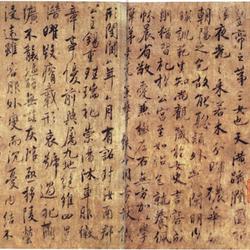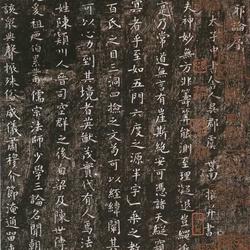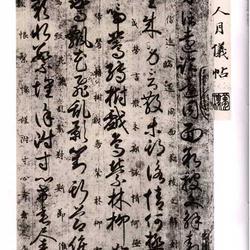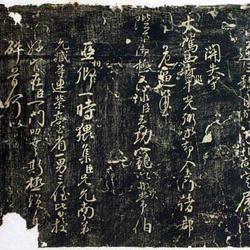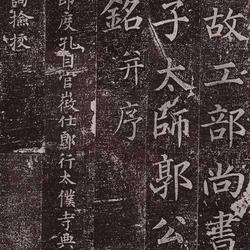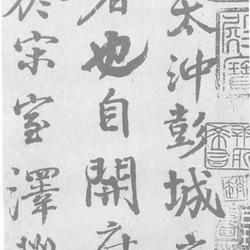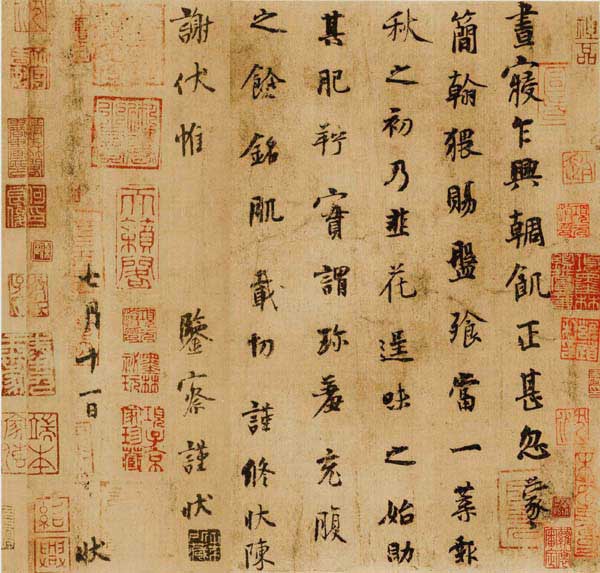
The copy collected by Luo Zhenyu can be found in "Dharma Books of Celebrities Collected by Bai Jue Zhai"
Explanation:
After sleeping in the day, I suddenly wake up, and I am very hungry. Suddenly, Jian Han gives me a plate of food. When a leaf announces the beginning of autumn, it is the beginning of the chive flower. Cha Jinzhu, July 11th
"Leek Flower Tie" is written in regular script and ink on linen paper. It is 26 cm high and 28 cm wide. It is Yang Ningshi's masterpiece. These are a few lines written by Yang Ningshi in order to thank his friends for the delicious chive flowers when he woke up from his nap and was very hungry. After filling his stomach with delicious food. Every seven lines, sixty-three characters. The whole text is filled with the author's relaxed, joyful and high-spirited enthusiasm, and his relaxed and leisurely mood is beyond words. His calligraphy is even more amazing. Yang Ningshi is "good at singing and poetry, and good at writing notes". This casual letter has become a rare masterpiece in the history of calligraphy.
Currently, there are three known copies of "Leek Hua Tie": one is from the collection of the Imperial Household of the Qing Dynasty and is now in the Wuxi Museum (see the picture below). It was once engraved in the "Sanxitang Dharma Tie"; the other is from the collection of Pei Boqian and is found in the "China Ink Dacheng" ", now lost; one is from Luo Zhenyu's collection (see picture above). Among the three volumes, only the one collected by Luo Zhenyu is authentic. This post has always been hidden in the palace as a royal treasure of emperors. It once entered the Xuanhe Inner Palace of Emperor Huizong of the Song Dynasty and the Shaoxing Inner Palace of the Southern Song Dynasty. This copy was collected by Zhang Yan in the Yuan Dynasty, along with Zhang Yan's postscript, and was handed over to Xiang Yuanbian and Wu Zhen in the Ming Dynasty. During the Qianlong Emperor's reign, a doctor in the Book of Records secretly exchanged a copy for a copy, risking the crime of exterminating his family. The copy was left in the palace and became the copy in the collection of the Qing dynasty. The original copy later found its way into the private sector and was purchased by Luo Zhenyu in the late Qing Dynasty. Its whereabouts are unknown today.
The broad and loose white of "Leek Flower Tie" should be its first eye-catching feature. There are large blank spaces between words and between lines, which is extremely strange in cursive calligraphy works. However, the implicit look and hope in the words are also connected. The most outstanding and amazing feature of "Leek Flower Tie" is the combination of ordinary things and extraordinary elements. It unifies the contradictions of closeness and dispersion, but it is not far-fetched in the slightest. Instead, it gives people a natural feeling and is full of curiosity. The whole article is like a leisurely and elegant scholar, with every move and gesture, everything is elegant and elegant, calm and composed. The scattered white cloth and the ordinary and strange combination complement each other, making the author's leisurely and leisurely mood vividly appear on the page. Whether it is the calligraphy itself or the text content, you can truly feel the author's relaxed state of mind.
Yang Ningshi introduced contradictions into calligraphy creation and achieved unprecedented artistic effects of harmony and unity. In addition to his extraordinary artistic skills and unique aesthetic taste, this is probably a true reflection of his realistic mentality. His life is also full of legend. Yang Ningshi became a Jinshi from the Zhaozong Dynasty of the Tang Dynasty, was awarded the title of Inspector of Branch, and moved to Secretary Lang and Zhishi Hall. In the Five Dynasties, he went from being a censor in the palace, such as Wailang and Sanchuan Shou, to being a Zhixian of Jixian Palace and a merit examiner, Wailang. From Bibu Langzhong, Zhi Zhigao, You Changshi, Gonghu Erbu Shilang, Military Bu Shilang, etc., to the last Zuopushe, Prince Taibao, he was given an imperial edict to the Prince Taifu after his death, and he served for five generations. During this period, he resigned from office due to illness several times, and entered the court as an official several times. From the end of the Tang Dynasty to the Five Dynasties, in just a few decades, dynasties changed several times, wars continued for years, and social conflicts were acute and complex. It can be said that turbulence ran through Yang Ningshi's life, dooming his life to be ups and downs. Yang Ningshi cannot escape all kinds of conflicts in real life. He hoped that the country would be peaceful and the people would be safe, so he actively participated in the world with his talents.

